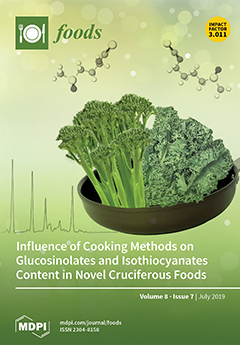The prevalence of
Bacillus cereus in a total of 585 samples of food products (herbs and spices, breakfast cereals, pasta, rice, infant formulas, pasteurized milk, fresh acid and acid/rennet cheeses, mold cheeses and ripening rennet cheeses) marketed in Poland was investigated. The potential
[...] Read more.
The prevalence of
Bacillus cereus in a total of 585 samples of food products (herbs and spices, breakfast cereals, pasta, rice, infant formulas, pasteurized milk, fresh acid and acid/rennet cheeses, mold cheeses and ripening rennet cheeses) marketed in Poland was investigated. The potential of 1022 selected isolates of
B. cereus to hydrolyze casein, starch and tributyrin, to ferment lactose, to grow at 7 °C/10 days, to produce Nhe and Hbl toxin and to possess the
ces gene was verified.
B. cereus was found in 38.8% of the analyzed samples, reaching levels from 0.3 to 3.8 log CFU g
−1 or mL
−1. From the 1022 isolates, 48.8%, 36.0%, 98.9%, 80.0% and 25.0% were capable of fermenting lactose, producing amylase, protease, lipase and growing at 7 °C/10 days, respectively, indicating spoilage potentiality. The occurrence of toxigenic
B. cereus strains in all tested market products, both of plant (55.8% Hbl(+), 70.7% Nhe(+) and 1.7%
ces(+) isolates) and animal origin (84.9% Hbl(+), 82.7% Nhe(+) and 0.9%
ces(+) isolates) indicates the possible risk of foodborne infections/intoxications that occur as a result of the possibility of the development of
B. cereus in favorable conditions and consumption of these products.
Full article






